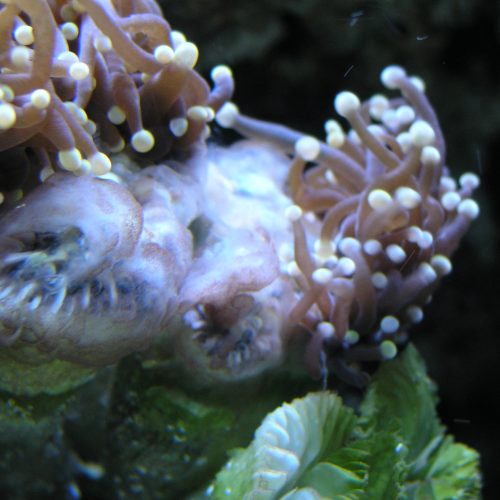
Image by user Tworoads on NanoReef.com
Preface: This Reef Mentoring article series is to document my recommendations to a hobbyist I have been mentoring. I am basically building a reef tank with his setup in my house and maintaining it for a year with weekly hands on sessions. The contract has been recently extended to a month to month till it can be relocated.
It has been 14 months since this series started back in November 2022. The WaterBox 30.2 AIO system has gone through the usual up and downs. In this article I will cover some of the recent issues encountered and how they were resolved.
Bacterial Infection on Torch Corals (Brown Jelly)
Historically some Large Polyp Stony corals seem to be prone to this Arcobacter infection due to poor water quality and/or unstable parameters impacting the coral’s health. As with all things in this hobby, research the latest information you can find about this issue before blindly acting on it. The understanding of each reef related topic is always evolving and there are many methods that seem to be effective for various hobbyists. Some include dipping with various disinfectants or whole tank treatments with an antibiotic. Note: everything has a level of risk so be aware that biology does not always have a single clear cut answer. As they say in the auto industry, “Your mileage may vary.”
The key is to always have various dips and medications on hand when you need them. I always have the following in case of emergencies.
- Dips: Hydrogen Peroxide, Iodine, Witch Hazel, Potassium Chloride, Hydroplex, TLF Revive, API MelaFix, CoralRx, PolypLab Reef Primer, and Bayer Complete.
- Medications/Treatments: Ciprofloxacin, Amoxicillin, Fluconazole, Metroplex, Interceptor or Milbemycin Oxime (MO), Chemi-Clean
Second, examine the system’s basic water chemistry values. The water parameters indicated the system alkalinity was running a bit lower than 7.8 dkh and the Kalkwasser dosing may not be enough to sustain the fast growing stony corals in this tank.
Third, check that the hardware is clean and operating at their optimum performance. During my examination I noticed a few things that had contributed to the degraded environment.
Initial Steps:
To document for my mentee, below were the steps taken.
- Manually siphoned off the brown mass to prevent it from spreading throughout the tank
- Removed the colonies and cut off the infected polyps. (Probably lost about 10 polyps overnight.)
- Dipped the remaining polyps in a mixture of existing tank water and iodine for 15 minutes while keeping the water circulating with my turkey baster.
- Rinsed with clean tank water in another container.
- Dipped in Revive for ~10 minutes, rinsed and returned to the tank.
- Performed a 50% water change.
Hardware Issues
- The bio-media seemed to be calcified over and was lowering the flow in the overflow of the rear AIO filtration area
- Action: Removed In-Tank Media Chamber and cleaned out filter floss and bio-media, replaced carbon and siphoned debris from bottom of chambers
- UV sterilizer pre-filter clogged due to calcification and UV bulb chamber leaked and shorted the bulb
- Action: Clean UV sterilizer unit. Water apparently leaked into the UV bulb chamber. I told my client I will throw it out since it is not reliable and order a drop in UV-C bulb for the rear chamber. Less moving parts with less potential for failure.
- Cleaned and recalibrated the pH probe to be sure the kalkwasser (calcium hydroxide) dosing is accurate since it was showing a pH between 8.35 and 8.45 during the low alkalinity period.
After a couple of days the remaining torch coral polyps recovered and everything in the tank looked better again. The 1 step I did not perform was to treat the entire system with an antibiotic. Typical choices had been ciprofloxacin, or ‘Chemi-clean’. There have been many questions about defining what the responsible use of antibiotics is in this hobby. Sometimes we tend to overmedicate without really knowing the long-term impacts to the system and externally. Luckily everything recovered in a period of a few days without this last step.
Clearly there was a lapse in monitoring the degradation of the tank environment on my part. Life got a bit busy and these types of things get unnoticed. Usually the term “Out of sight, out of mind” is very applicable here. This system does not have all the automated monitoring I installed on my main system. This can be a proponent for additional automation if the hobbyist is not willing to perform more regular water testing or revert back to basic consistent water changing routines.
Summary
Bad things happen in this hobby but they are learning experiences nonetheless. The best way is to learn from these experiences yourself and apply the best knowledge possible to address it. If the method worked then you now have a tool in your back pocket to use again in the future. Also the understanding that this problem could also have been prevented drives home the importance of maintaining best practices. Proper water quality maintenance techniques the community have collectively stood behind should always be paramount. Goes to show that going back to basics is really all you need. It really does not matter how many years you are in the hobby, life happens!










0 Comments